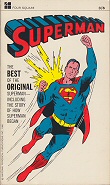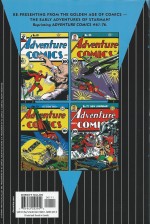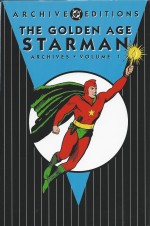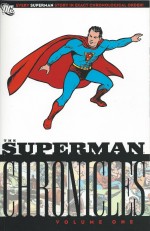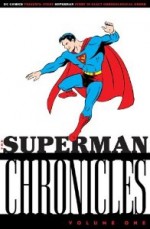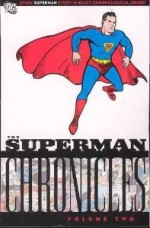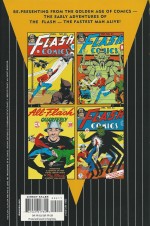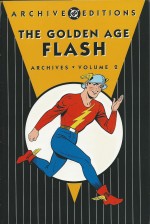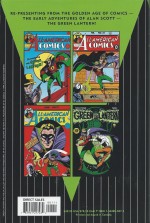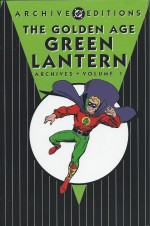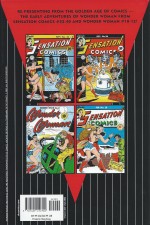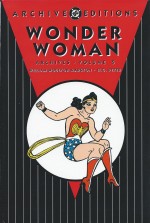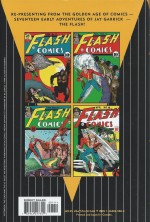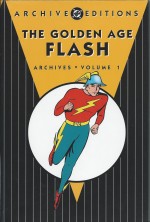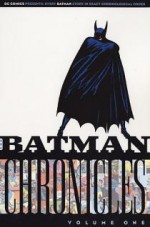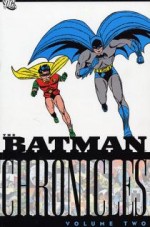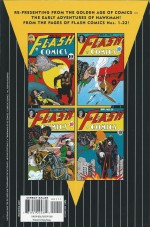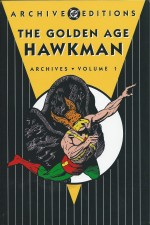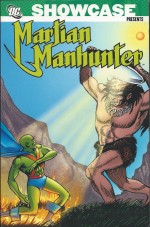
By Jack Miller & Joe Certa & various (DC Comics)
ISBN: 978-1-4012-1368-8
As the 1950’s opened, comicbook superheroes were in a steep decline, giving way to a steady stream of genre-based he-men and “Ordinary Joes†in extraordinary circumstances.
By the time the “Red-baitingâ€, witch-hunting Senate hearings and media investigations into causes of juvenile delinquency had finished, the industry was further depleted by the excision of any kind of reference to mature themes or content. The self-imposed Comics Code Authority took all the hard edges out of the industry, banning horror and crime comics whilst leaving their ghostly, sanitised anodyne shades to inhabit the remaining adventure, western, war and fantasy titles that remained.
American comics could have the bowdlerised concept of evil and felonious conduct but not the simplest kind of repercussion: a world where mad scientists plotted to conquer humanity without killing anybody, and cowboys shot guns out of opponents’ hands and severed gun-belts with a well-aimed bullet, without ever drawing blood…
Moreover no civil or government official or public servant could be depicted as anything other than a saint…
With corruption, venality and menace removed from the equation, comics were forced to supply suspense and tension to their works via mystery and imagination – but only as long as it all had a rational, non-supernatural explanation…
Arguably the first superhero of the Silver Age, beating by a year the new Flash (who launched in Showcase #4 cover-dated October 1956), the series depicting the clandestine adventures of stranded alien J’onn J’onzz was initially entitled John Jones, Manhunter from Mars; an eccentric, often formulaic but never disappointing B-feature strip which debuted at the height of American Flying Saucer fever in Detective Comics #225.
Hardly evolving at all – except for finally going public as a superhero in Detective Comics #273 (November 1959) – the police-based strip ran there until #326, (1955 to 1964) before shifting over to The House of Mystery and a whole new modus vivendi, beginning with #143 where he continued until #173, finally fading away during the Great Superhero Cull of 1968-70.
In volume 1 ‘The Strange Experiment of Dr. Erdel’ described how a reclusive genius built a robot-brain which could access Time, Space and the Fourth Dimension, accidentally plucking an alien scientist from his home on Mars. After a brief conversation with his unfortunate guest, Erdel succumbed to a heart attack whilst attempting to return the incredible J’onn J’onzz to his point of origin.
Marooned on Earth the Martian discovered that his new home was riddled with the ancient and primitive cancer of Crime and, being decent and right-thinking, determined to use his natural abilities (which included telepathy, psychokinesis, shape-shifting, invisibility, intangibility, super-strength, speed, flight, vision, super-breath, invulnerability and many others) to eradicate the evil, working clandestinely disguised as a human policeman. His only concern was the commonplace chemical reaction of fire which sapped Martians of all their mighty powers…
With his name Americanised to John Jones he enlisted as a Police Detective in Middletown and worked tirelessly to improve his new home; fighting evil secretly using his inherent powers and advanced knowledge with no human even aware of his existence.
This second and final Silver Age selection reprints in moody monochrome Detective Comics #305-226 (July 1962-April 1964) and the Manhunter’s entire House of Mystery career (#143-173, from July 1964-March-April 1968), almost all of which were written by Jack Miller and illustrated by the indefatigable Joe Certa.
One of the longest tenures and partnerships in DC comics’ history (although creator records are sadly incomplete), Miller and perhaps Bob Haney produced a wealth of scripts for veteran illustrator Certa, who had previously worked for the Funnies Incorporated comics “Shop†and all over the industry.
His other credits included work on Captain Marvel Junior and assorted genre titles for Magazine Enterprises (Dan’l Boone, Durango Kid), Lev Gleason’s crime comics, Harvey romance titles and others, whilst at DC he drew nautical sleuth Captain Compass and many anthology tales for such titles as Gang Busters and House of Mystery. Certa also drew the newspaper strip Straight Arrow and ghosted the long-lived boxing legend Joe Palooka. In the 1970s he moved to Gold Key, working on TV adaptations, mystery tales and all-ages horror stories.
This traditional all-ages delight opens with ‘J’onn J’onzz vs. Futureman’ from Detective Comics #305 wherein a cop from the 30th century followed a Martian lawbreaker back to 1962 and mistook J’onzz for his fugitive quarry. When malign B’enn B’urnzz then aligned himself with ruthless earth criminals, the stage was set for a spectacular super-power showdown…
In #306 criminals using fantastic robot animals were given an unexpected boost when a blazing meteor sapped the Manhunter’s life force and almost spelled ‘The Last Days of J’onn J’onzz’, whilst a bewildering display of disguises and quick-changes was necessary to save John Jones’ police partner Diane Meade when the detective – ‘Alias Scarface Scanlon’– went undercover to expose a criminal safe-house in #307.
Detective Comics #308 revealed how a visit to a feudal European county found the Alien Adventurer embroiled in a coup and battling ancient magic on ‘The Day John Jones Vanished!‘ after which he foiled an alien invasion whilst wearing the form of a reclusive human as ‘The Man Who Saved Earth’ in #309 and overcame a cunning crook with a shrinking ray in #310’s ‘The Miniature Manhunter’
Vacationing Diane was on JadeIsland when it became the beachhead for ‘The Invaders from the Space Warp’ in #311, but to defeat the uncanny extra-dimensional thieves, J’onzz also needed the aid of friendly alien R’ell and his uncanny talking pet. When the war was over, however, the bizarre Zook was trapped on our world forever…
A new era began in #312 as the cute E.T. became ‘J’onn J’onzz’ Pesky Partner’. Zook could change shape, generate extremes of heat and cold and had the mind of a five-year old, but posed a frequent threat to the hero’s secret identity by slavishly trailing him as he hunted crooks…
The kid learned quickly though and by #313, wherein ‘The Wizard who Conquered J’onn J’onzz’ almost killed the Martian with a stolen magic wand, Zook had adapted to a life of seclusion on Earth as the hero’s secret weapon. He proved his worth in #314 when a shape-shifting Saturnian stole the detective’s identity in ‘J’onn J’onzz vs. John Jones’ and the extra-dimensional ET helped defeat a villain as powerful as Manhunter himself, and again in #315 when his uncanny senses penetrated the various identities of a crooked stage performer who was also ‘The Man of 1000 Disguises’…
Another bizarre meteor transferred all the hero’s abilities to ‘The Bandits with Super-Powers’ in Detective #316, but Zook and an equally Martian-powered Diane proved up to the task of thwarting them, after which J’onzz, Diane and Zook had their hands full dealing with ‘The Challenge of the Alien Robots’ found by ambitious, greedy human bandit Jasper Dowd in #317
When the terrific tyke took a blow to the head he briefly became ‘J’onn J’onzz’ Enemy – Zook’ but was restored by another bash on the bonce, after which the vacationing police detective strolled through a time warp and into a war of succession in mediaeval Auvergne, restoring rightful ruler Prince Charles to his stolen throne as ‘J’onn J’onzz – Wizard of 1463’.
Back in the 20th century, #320 saw the detective Jones and Zook solve ‘The Case of the Golden Eagle’ and restore a lost treasure to France, whilst #321 found the Martian and his pal battling the fantastic shape-shifting threat of ‘The Cosmic Creature’, after which an old Batman villain moved from Gotham to Middletown intent on becoming ‘The Man who Destroyed J’onn J’onzz’ in #322.
Professor Arnold Hugo had enlarged his intellect – and cranium – to become a cerebral super-villain whose devices enabled him to steal the hero’s powers. However the wily mastermind had not realised that the ludicrous-seeming pet Zook was privy to his fallen friend’s weaknesses too…
In Detective #323 the Manhunter flew solo on ‘The Hobby Missions’ wherein a charity auction for his services was suborned by a vicious criminal seeking lost artefacts which bestowed awesome power, whilst in #324 the hero tackled a bizarre rampaging monster and was trapped in a hideous bestial form, becoming ‘The Beast who was J’onn J’onzz’ until Zook intervened, after which a crook’s time-ray banished the hero to Ancient Greece where he helped ‘The Hero of 500 B.C.’ battle incredible beasts until Zook could rescue him…
Big changes were in the air at DC and by the end of 1963 Julius Schwartz, who had revived much of DC’s line – and the entire industry – with his modernization of the superhero, was then asked to work his magic with the creatively stalled and nigh-moribund Caped Crusader.
Bringing his usual team of top-notch creators with him, Schwartz stripped down the core-concept, downplaying all the aliens, outlandish villains and daft transformation tales, bringing a cool modern take to the capture of criminals and even overseeing a streamlining rationalisation of the art style itself. The most apparent change to us kids was a yellow circle around the Bat-symbol but, far more importantly, the stories also changed. A subtle aura of genuine menace had re-entered the comfortable and absurdly abstract world of GothamCity.
The “New Look†Batman debuted in Detective Comics #327 and changed the shape of the industry but as part of the makeover the increasingly fantastic Martian Manhunter was no longer welcome.
In a rare move for the genre at the time, departing Bat-Editor Jack Schiff, who was taking J’onzz with him to his new post, decided to shake up everything and end the era in style so Detective Comics #326 (April 1964) marked ‘The Death of John Jones, Detective’ as the veteran cop was dispatched to investigate the theft of The Idol-Head of Diabolu and discovered that the outré relic was in fact a terrifying portal to uncountable extra-dimensional horrors.
When it transformed the thief who took it into a deadly menace, it also unleashed a dreadful beast which apparently killed the valiant cop before Manhunter ended the twin threats. However the unleashed Idol-Head was lost and promised to unleash a new menace at every first full moon, so the Manhunter gave up his human identity forever, leaving Middletown and swearing to track down the mystic menace whatever the cost…
Thus the oldest Silver Age superhero moved over to House of Mystery (from #143, June 1964, and finally getting his to feature on covers) where, in keeping with the title and context of his new home, he became a wandering monster-hunter.
But don’t panic, chums, Zook came with him…
J’onnz’ adventures began as the Idol disgorged ‘The Giant-Maker’, a beast which transformed men – and poor Zook – into rampaging colossi and freed the wicked wizard Malador from millennia of bondage until the Manhunter stopped the dual dangers, whilst one full moon later in HoM #144 the peripatetic head opened a voracious space warp which sucked people into ‘The Weird World of Gilgana’ until J’onnz plunged in to seal the breach.
Issue #145 revealed the ‘Secret of the Purple People’ when the Idol allowed the metamorphic Venomee to ravage Egypt until Zook and the Martian stopped them, whilst #146 saw the wanderers find and lose the Diabolu head to fantastic cat-beast Aroo but still save Earth from the life-sucking, monstrous Chulko in ‘The Doom Shadow’…
In #147 the Idol vomited forth living, malevolent musical instruments who mesmerised humans as ‘The Orchestra of Doom!’, whilst #148 unleashed ‘The Beings in the Color Rings’ which warped physical reality in ghastly ways.
An unwary beachcomber became ‘The Man-Thing that Unearthed Secrets’ in #149, changing into a succession of incredible creatures and compulsively retrieving lost mystic artefacts, whilst in #150 an artist’s brushes were ensorcelled and permitted the creation of ‘The Supernatural Masterpieces!’ with calamitous results…
‘The Doom from Two Worlds’ split J’onzz and Zook as the Manhunter battled horrors in a trans-dimensional nightmare world whilst his pal was left to defend Earth from a rapacious fire-demon, following which HoM #152 ‘Iwangis – Creature King’ saw a bestial stone giant lead an army of monsters against humanity…
There was a brief busman’s holiday in #153 when Professor Hugo again reared his outlandish, oversized head to awaken and enslave ‘The Giants Who Slept 1,000,000 Years’ for an orgy of destruction and profit, whilst in #154 convict Orry Kane used a stolen magic looking-glass to create ‘The Mirror Martian Manhunter’ – a distorted, devilish doppelganger which needed the Manhunter to exercise his wits as well as his powers to exorcise…
The Idol-Head of Diabolu returned in #155 unleashing ‘The Giant Genie of Gensu’ to grant the wishes of evil men, but comicbook fashions were changing again and the Manhunter was about to be relegated to a B-Feature once more…
The entire world was going crazy for costumed crusaders in the mid-Sixties, and every comicbook publisher was keenly seeking new ways to repackage an extremely exciting yet intrinsically limited concept. Perhaps its ultimate expression came with the creation of teen-aged everyman Robby Reed who battled crime and disaster in his little town with the aid of a fantastic wonder-tool in Dial H for Hero…
Taking the lead from House of Mystery #156 (January 1966), the birth of this new and outlandish hero pushed J’onzz into the back-up spot for ‘Look What Happened to J’onn J’onzz!’, a position he maintained until #173 (March-April 1968) when the comicbook disappeared for a few months to re-emerge as DC’s first – of many – modern anthological supernatural mystery titles.
In that truncated tale a sinister snake-beast almost absorbed and consumed the valiant Martian (irony, or what?), whilst in #157 Professor Hugo returned to mesmerise and humiliate his alien nemesis in ‘Manhunter, World’s Greatest Clown!’
House of Mystery #158 ended the long-running and now tired saga by revealing ‘The Origin of the Diabolu Idol-Head’ by plunging Manhunter back in time to Ancient Babylonia where the Martian finally learned how to destroy it, after which J’onzz marked the occasion by returning to his roots and foiling an invasion by ‘The Devil Men of Pluto’ in #159.
Apparently a helpless victim of trends, ‘Manhunter’s New Secret Identity’ debuted in HoM #160 (July 1966) as the hero tapped into the global super-spy fad by taking over the identity of an international playboy and suspected criminal to penetrate the inner echelons of sinister secret society Vulture. Soon he was popping up all over Europe, hot on the trail of mysterious leader Faceless, AKA “Mr. Vâ€, forced to undertake increasingly suspect tasks and missions which threatened to compromise his ethics and integrity if not end his life…
He was almost immediately rumbled in #161 when ‘The Unmasking of Marco Xavier!’ found him battling Vulture’s top operative Abba Sulkar and only a tragic accident saved his stolen face.
A devious courier mission for Xavier in #162 allowed Manhunter to raid ‘The Lair of Mr. V!’ but Faceless proved to be a truly capable foe who easily eluded him, whilst in #163 an alliance between Vulture and a fugitive Mercurian resulted in the Martian becoming ‘The Doomed Captive!’ until the hero’s brains triumphed over the bad guys’ brawn and science…
In #164 the undercover agent was placed in an impossible position when Faceless ordered a hit on J’onn J’onzz and expected his playboy pal to carry it out. ‘Marco vs. Manhunter!’ offered a bewildering display of the hero’s disguise dexterity, whilst the next devilish ploy of Professor Hugo provided an unwelcome break as the rogue genius used nuclear blackmail and atomic science to transform the hero into ‘The Deadly Martian’…
When the infiltration campaign had begun Zook had been abandoned in America, but he popped up again in #166 after Marco Xavier was dispatched to the States to secure the secret of turning men into monsters in ‘Vulture’s Crime Goliaths!’
On arrival back in Europe, Faceless tasked his playboy pawn with ingratiating himself with the enemy. ‘Marco Xavier, Manhunter’s Ally!’ proved to be a complex and ultimately unrewarding mission after which Zook called J’onzz back to the USA to tackle the alien predations of ‘Thantos – the 3-in-1 Man!’ in #168, before ‘The Manhunter Monster!’ saw the hero infiltrate Mr. V’s secret lab and become stuck in the shape of the gang’s latest horrific bio-weapon…
Events in the real world were starting to affect comicbooks, and after #170’s ‘The Martian Double-Cross!’ saw “Xavier†wrongly deduce the Manhunter’s weakness and only narrowly survive his failure, House of Mystery underwent a radical remodelling to display a slightly darker tone. The writing was clearly on the wall for exuberant, angst-free adventurers…
With #171 Zook was back for good and in ‘The Martian Marauders’ the odd couple battled an expeditionary force of invaders from the Manhunter’s home-world, whilst #172 found the hero mind-swapped and prisoner in the body of a Vulture assassin as the killer wore his alien frame in ‘Manhunter’s Stolen Identity!’
In those distant days series ended abruptly, without fanfare and often in the middle of something – and such was the fate of Robby Reed – but for J’onn J’onzz at least HoM#173 (March/April 1968) managed – admittedly in an abbreviated manner – to wrap up the undercover agent’s mission in the climactic and explosive ‘So You’re Faceless!’
And that was that. The series was gone, the market was again abandoning Fights ‘n’ Tights fiction, and on the horizon a host of war, western, barbarian and horror comics were beginning to emerge…
Exciting, fun, engaging and silly in equal amounts (heck, even I couldn’t resist a jibe or too and I genuinely revere these daft, nostalgia-soaked gems) J’onzz has been subsequently re-imagined a number of time since these innocent odysseys first ran, but never with the clear-cut, unsophisticated, welcoming charm displayed here.
Although certainly dated and definitely formulaic, these complex yet uncomplicated adventures are drenched in charm and still sparkle with innocent wit and wonder. Perhaps not to everyone’s taste nowadays, these exploits of the Manhunter from Mars are nevertheless an all-ages buffet of fun, thrills and action no fan should miss.
© 1962-1968, 2009 DC Comics. All Rights Reserved.
